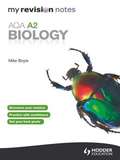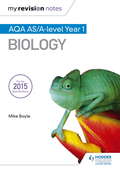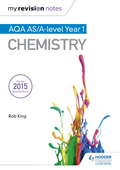- Table View
- List View
My Revision Notes: AQA A-level Physics
by Keith GibbsWith My Revision Notes: AQA A Level Physics you can:- Manage your own revision with step-by-step support from experienced teacher and examiner Keith Gibbs- Apply biological terms accurately with the help of definitions and key words- Plan and pace your revision with the revision planner- Test understanding with questions throughout the book- Get exam ready with last minute quick quizzes available on the Hodder Education website
My Revision Notes: AQA A-level Physics
by Keith GibbsExam Board: AQALevel: AS/A-levelSubject: PhysicsFirst Teaching: September 2015First Exam: June 2016With My Revision Notes: AQA A Level Physics you can:- Manage your own revision with step-by-step support from experienced teacher and examiner Keith Gibbs- Apply biological terms accurately with the help of definitions and key words- Plan and pace your revision with the revision planner- Test understanding with questions throughout the book- Get exam ready with last minute quick quizzes available on the Hodder Education website
My Revision Notes: AQA A2 Biology eBook ePub
by Mike BoyleUnlock your full potential with these revision guides which focus on the key content and skills you need to know.With My Revision Notes for AQA A2 Biology you can:Take control of your revision: plan and focus on the areas you need to revise with content summaries and commentary from author Mike BoyleShow you fully understand key topics by using the examples to add depth to your knowledge of biological processes and applicationsApply biological terms accurately with the help of definitions and key words on all topicsImprove your skills to tackle exam questions, with self-testing and exam-style questions and answersGet exam-ready with last-minute quick quizzes at http://www.hodderplus.co.uk/myrevisionnotes
My Revision Notes: AQA A2 Chemistry ePub
by Rob KingUnlock your full potential with these revision guides which focus on the key content and skills you need to know.With My Revision Notes for AQA A2 Chemistry you can: Take control of your revision: plan and focus on the areas you need to revise with content summaries and commentary from author Rob KingUse the worked examples to improve your understanding of chemical calculationsApply chemical terms accurately with the help of definitions and key words on all topicsImprove your skills to tackle specific exam questions such as [subject example] with self-testing and exam-style questions and answersGet exam-ready with last-minute quick quizzes at www.hodderplus.co.uk/myrevisionnotes
My Revision Notes: AQA AS Biology Second Edition
by Mike BoyleWith My Revision Notes you can:- Manage your own revision with step-by-step support from experienced teacher and former examiner Mike Boyle- Apply biological terms accurately with the help of definitions and key words- Plan and pace your revision with the revision planner- Test understanding with questions throughout the book- Get exam ready with last minute quick quizzes available on the Hodder Education website
My Revision Notes: AQA AS Chemistry Second Edition
by Rob KingWith My Revision Notes you can:- Manage your own revision with step-by-step support from experienced teacher Rob King- Apply chemical terms accurately with the help of definitions and key words- Plan and pace your revision with the revision planner- Test understanding with questions throughout- Get exam ready with last minute quick quizzes available on the Hodder Education website
My Revision Notes: AQA AS Chemistry ePub
by Rob KingGet the best grades with My Revision Notes: AQA AS Chemistry.Manage your own revision with step-by-step support from former examiner Rob KingUse the worked examples to improve your understanding of chemical calculationsGet the top marks by applying chemical terms accurately with the help of definitions and key wordsImprove your exam skills with the help of self-testing and exam-style questions and answersMy Revision Notes will help you prepare for the big day:Plan and pace your revision with My Revision PlannerUse the concise notes to revise the essential informationUse the examiner's tips and summaries to clarify key pointsAvoid making typical mistakes with expert adviceTest yourself with end-of-topic questions and answers and tick off each topic as you complete itPractise your exam skills on exam questions then check your answers onlineGet exam-ready with last-minute quick quizzes at www.therevisionbutton.co.uk/myrevisionnotes
My Revision Notes: AQA AS Physics
by Keith GibbsWith My Revision Notes you can:-Manage your own revision with step-by-step support from experienced teacher and author Keith Gibbs-Apply physical terms accurately with the help of definitions and key words-Plan and pace your revision with the revision planner-Test understanding with questions throughout-Get exam ready with last minute quick quizzes available on the Hodder Education website
My Revision Notes: AQA GCSE (9-1) Biology
by Nick DixonExam Board: AQALevel: GCSESubject: BiologyFirst Teaching: September 2016First Exam: Summer 2018Unlock your students' full potential with these revision guides from our best-selling series My Revision NotesWith My Revision Notes your students can:- Manage their own revision with step-by-step support from experienced teachers with examining experience.- Apply scientific terms accurately with the help of definitions and key words.- Prepare for practicals with questions based on practical work.- Focus on the key points from each topic- Plan and pace their revision with the revision planner.- Test understanding with end-of-topic questions and answers.- Get exam ready with last minute quick quizzes available on the Hodder Education Website.
My Revision Notes: AQA GCSE (9-1) Biology
by Nick DixonExam Board: AQALevel: GCSESubject: BiologyFirst Teaching: September 2016First Exam: Summer 2018Unlock your students' full potential with these revision guides from our best-selling series My Revision NotesWith My Revision Notes your students can:- Manage their own revision with step-by-step support from experienced teachers with examining experience.- Apply scientific terms accurately with the help of definitions and key words.- Prepare for practicals with questions based on practical work.- Focus on the key points from each topic- Plan and pace their revision with the revision planner.- Test understanding with end-of-topic questions and answers.- Get exam ready with last minute quick quizzes available on the Hodder Education Website.
My Revision Notes: AQA GCSE (9-1) Chemistry
by Richard GrimeExam Board: AQALevel: GCSESubject: ChemistryFirst Teaching: September 2016First Exam: Summer 2018Unlock your students' full potential with these revision guides from our best-selling series My Revision NotesWith My Revision Notes your students can:- Manage their own revision with step-by-step support from experienced teachers with examining experience.- Apply scientific terms accurately with the help of definitions and key words.- Prepare for practicals with questions based on practical work.- Focus on the key points from each topic- Plan and pace their revision with the revision planner.- Test understanding with end-of-topic questions and answers.- Get exam ready with last minute quick quizzes available on the Hodder Education Website.
My Revision Notes: AQA GCSE (9-1) Chemistry
by Richard GrimeExam Board: AQALevel: GCSESubject: ChemistryFirst Teaching: September 2016First Exam: Summer 2018Unlock your students' full potential with these revision guides from our best-selling series My Revision NotesWith My Revision Notes your students can:- Manage their own revision with step-by-step support from experienced teachers with examining experience.- Apply scientific terms accurately with the help of definitions and key words.- Prepare for practicals with questions based on practical work.- Focus on the key points from each topic- Plan and pace their revision with the revision planner.- Test understanding with end-of-topic questions and answers.- Get exam ready with last minute quick quizzes available on the Hodder Education Website.
My Revision Notes: AQA GCSE (9-1) Combined Science Trilogy
by Nick England Nick Dixon Richard GrimeExam Board: AQALevel: GCSESubject: Combined ScienceFirst Teaching: September 2016First Exam: Summer 2018Unlock your students' full potential with these revision guides from our best-selling series My Revision NotesWith My Revision Notes your students can:- Manage their own revision with step-by-step support from experienced teachers with examining experience.- Apply scientific terms accurately with the help of definitions and key words.- Prepare for practicals with questions based on practical work.- Focus on the key points from each topic- Plan and pace their revision with the revision planner.- Test understanding with end-of-topic questions and answers.- Get exam ready with last minute quick quizzes available on the Hodder Education Website.
My Revision Notes: AQA GCSE (9-1) Combined Science Trilogy
by Nick England Nick Dixon Richard GrimeExam Board: AQALevel: GCSESubject: Combined ScienceFirst Teaching: September 2016First Exam: Summer 2018Unlock your students' full potential with these revision guides from our best-selling series My Revision NotesWith My Revision Notes your students can:- Manage their own revision with step-by-step support from experienced teachers with examining experience.- Apply scientific terms accurately with the help of definitions and key words.- Prepare for practicals with questions based on practical work.- Focus on the key points from each topic- Plan and pace their revision with the revision planner.- Test understanding with end-of-topic questions and answers.- Get exam ready with last minute quick quizzes available on the Hodder Education Website.
My Revision Notes: AQA GCSE (9-1) Physics
by Nick EnglandExam Board: AQALevel: GCSESubject: PhysicsFirst Teaching: September 2016First Exam: Summer 2018Unlock your students' full potential with these revision guides from our best-selling series My Revision Notes.With My Revision Notes your students can:- Manage their own revision with step-by-step support from experienced teachers with examining experience.- Apply scientific terms accurately with the help of definitions and key words.- Prepare for practicals with questions based on practical work.- Focus on the key points from each topic- Plan and pace their revision with the revision planner.- Test understanding with end-of-topic questions and answers.- Get exam ready with last minute quick quizzes available on the Hodder Education Website.
My Revision Notes: AQA GCSE (9-1) Physics
by Nick EnglandExam Board: AQALevel: GCSESubject: PhysicsFirst Teaching: September 2016First Exam: Summer 2018Unlock your students' full potential with these revision guides from our best-selling series My Revision Notes.With My Revision Notes your students can:- Manage their own revision with step-by-step support from experienced teachers with examining experience.- Apply scientific terms accurately with the help of definitions and key words.- Prepare for practicals with questions based on practical work.- Focus on the key points from each topic- Plan and pace their revision with the revision planner.- Test understanding with end-of-topic questions and answers.- Get exam ready with last minute quick quizzes available on the Hodder Education Website.
My Revision Notes: AQA GCSE (My Revision Notes)
by Ian Fawcett Pauline Treuherz Debbie TranterExam board: AQALevel: GCSESubject: Design and TechnologyFirst teaching: September 2017First exams: Summer 2019Target success in AQA GCSE (9-1) Design and Technology with this proven formula for effective, structured revision. Key content coverage is combined with exam-style tasks and practical tips to create a revision guide that students can rely on to review, strengthen and test their knowledge.This revision guide is for you if you have chosen to study textile-based materials in greater depth.With My Revision Notes, every student can:- plan and manage a successful revision programme using the topic-by-topic planner- consolidate subject knowledge by working through clear and focused content coverage- test understanding and identify areas for improvement with regular 'Now Test Yourself' tasks and answers- improve exam technique through practice questions, expert tips and examples of typical mistakes to avoid- get exam ready with extra quick quizzes and answers to the practice questions available online
My Revision Notes: AQA GCSE (My Revision Notes)
by Ian Fawcett Pauline Treuherz Debbie TranterExam board: AQALevel: GCSESubject: Design and TechnologyFirst teaching: September 2017First exams: Summer 2019Target success in AQA GCSE (9-1) Design and Technology with this proven formula for effective, structured revision. Key content coverage is combined with exam-style tasks and practical tips to create a revision guide that students can rely on to review, strengthen and test their knowledge.This revision guide is for you if you have chosen to study papers and boards in greater depth.With My Revision Notes, every student can:- plan and manage a successful revision programme using the topic-by-topic planner- consolidate subject knowledge by working through clear and focused content coverage- test understanding and identify areas for improvement with regular 'Now Test Yourself' tasks and answers- improve exam technique through practice questions, expert tips and examples of typical mistakes to avoid- get exam ready with extra quick quizzes and answers to the practice questions available online.
My Revision Notes: AQA GCSE Biology (for A* to C) ePub
by Mike BoyleAiming for your very best grades in AQA GCSE Biology? This revision guide will support you every step of the way.My Revision Notes (for A* to C): AQA GCSE Biology will help you revise effectively in the way you want to, allowing you to plan and pace your revision according to your learning needs, and to adapt and personalise with your own notes. Written by experienced teachers and examiners, you can be confident that this guide will cover only the facts and ideas you will be expected to recall and be able to use. With My Revision Notes (for A* to C): AQA GCSE Biology, essential facts are organised into memorable portions to make revising easier. Each double-page spread summarises a key topic for AQA GCSE Biology and is packed with questions and quick-fire quizzes so you can test your understanding and track your progress. Exam tips and hints then show you how to avoid losing marks and get the best grades. With additional online support and advice on using terms and applying your scientific skills, this guide will help you prepare for your top grades.
My Revision Notes: AQA GCSE Chemistry (for A* to C) ePub
by Philip DobsonAiming for your very best grades in AQA GCSE Chemistry? This revision guide will support you every step of the way.My Revision Notes (for A* to C): AQA GCSE Chemistry will help you revise effectively in the way you want to, allowing you to plan and pace your revision according to your learning needs, and to adapt and personalise with your own notes. Written by experienced teachers and examiners, you can be confident that this guide will cover only the facts and ideas you will be expected to recall and be able to use. With My Revision Notes (for A* to C): AQA GCSE Chemistry, essential facts are organised into memorable portions to make revising easier. Each double-page spread summarises a key topic for AQA GCSE Chemistry and is packed with questions and quick-fire quizzes so you can test your understanding and track your progress. Exam tips and hints then show you how to avoid losing marks and get the best grades. With additional online support and advice on using terms and applying your scientific skills, this guide will help you prepare for your top grades.
My Revision Notes: AQA GCSE Physics (for A* to C) ePub
by Steve WitneyAiming for your very best grades in AQA GCSE Physics? This revision guide will support you every step of the way.My Revision Notes (for A* to C): AQA GCSE Physics will help you revise effectively in the way you want to, allowing you to plan and pace your revision according to your learning needs, and to adapt and personalise with your own notes. Written by experienced teachers and examiners, you can be confident that this guide will cover only the facts and ideas you will be expected to recall and be able to use. With My Revision Notes (for A* to C): AQA GCSE Physics, essential facts are organised into memorable portions to make revising easier. Each double-page spread summarises a key topic for AQA GCSE Physics and is packed with questions and quick-fire quizzes so you can test your understanding and track your progress. Exam tips and hints then show you how to avoid losing marks and get the best grades. With additional online support and advice on using terms and applying your scientific skills, this guide will help you prepare for your top grades.
My Revision Notes: CCEA GCSE Biology
by James NapierTarget success in CCEA GCSE Biology with this proven formula for effective, structured revision; key content coverage is combined with exam-style tasks and practical tips to create a revision guide that students can rely on to review, strengthen and test their knowledge.With My Revision Notes, every student can:- Plan and manage a successful revision programme using the topic-by-topic planner- Consolidate subject knowledge by working through clear and focused content coverage- Test understanding and identify areas for improvement with regular 'Now Test Yourself' tasks and answers- Improve exam technique through practice questions, expert tips and examples of typical mistakes to avoid- Get exam ready with extra quick quizzes and answers to the practice questions available online
My Revision Notes: CCEA GCSE Biology
by James NapierTarget success in CCEA GCSE Biology with this proven formula for effective, structured revision; key content coverage is combined with exam-style tasks and practical tips to create a revision guide that students can rely on to review, strengthen and test their knowledge.With My Revision Notes, every student can:- Plan and manage a successful revision programme using the topic-by-topic planner- Consolidate subject knowledge by working through clear and focused content coverage- Test understanding and identify areas for improvement with regular 'Now Test Yourself' tasks and answers- Improve exam technique through practice questions, expert tips and examples of typical mistakes to avoid- Get exam ready with extra quick quizzes and answers to the practice questions available online
My Revision Notes: CCEA GCSE Chemistry
by Alyn G. McFarlandTarget success in CCEA GCSE Chemistry with this proven formula for effective, structured revision; key content coverage is combined with exam-style tasks and practical tips to create a revision guide that students can rely on to review, strengthen and test their knowledge.With My Revision Notes, every student can:- Plan and manage a successful revision programme using the topic-by-topic planner- Consolidate subject knowledge by working through clear and focused content coverage- Test understanding and identify areas for improvement with regular 'Now Test Yourself' tasks and answers- Improve exam technique through practice questions, expert tips and examples of typical mistakes to avoid- Answers to the practice questions available online
My Revision Notes: CCEA GCSE Chemistry
by Alyn G. McFarlandTarget success in CCEA GCSE Chemistry with this proven formula for effective, structured revision; key content coverage is combined with exam-style tasks and practical tips to create a revision guide that students can rely on to review, strengthen and test their knowledge.With My Revision Notes, every student can:- Plan and manage a successful revision programme using the topic-by-topic planner- Consolidate subject knowledge by working through clear and focused content coverage- Test understanding and identify areas for improvement with regular 'Now Test Yourself' tasks and answers- Improve exam technique through practice questions, expert tips and examples of typical mistakes to avoid- Answers to the practice questions available online

















